Hello neighbors!
With the recent stretch of hot and humid weather, you might be noticing some unusual spots, colors, or textures showing up in your lawn. While it’s easy to blame insects or drought, you could be looking at a common turfgrass fungus.
Fungi are a natural part of any lawn's ecosystem, but under the right conditions—like the heat and humidity we’ve been experiencing—they can multiply and become visible, causing aesthetic damage or, in some cases, serious harm to your turf.
Cosmetic Concerns: The Leaf-Affecting Fungi
These fungi primarily affect the blades of the grass, not the crown or the roots. While they can look alarming, they rarely kill the grass and can often be managed with good cultural practices.
1. Red Thread
If you see irregular, pinkish-red patches on your lawn, you might have Red Thread. Upon closer inspection, you'll notice red, thread-like strands extending from the tips of the grass blades.
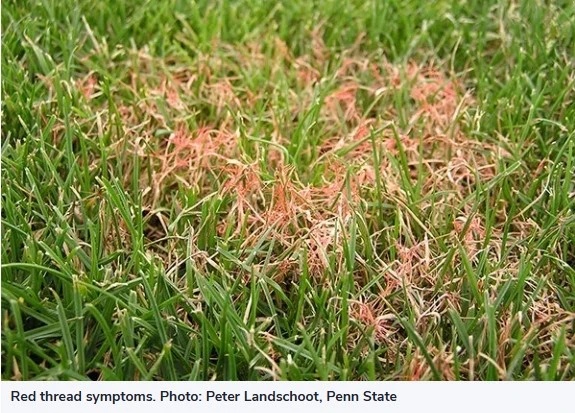
-
What it is: A foliar disease that is most common in the cool, wet weather of spring and fall.
-
Threat Level: Low. According to the University of Minnesota Extension, Red Thread is a cosmetic issue and does not harm the roots or crown of the plant. Lawns typically recover.
-
Key Cause: A primary cause is low nitrogen fertility. If your lawn is under-fertilized, it's more susceptible.
-
Treatment: The best control is proper fertilization. A balanced fertility program usually clears up the issue. Fungicide is typically not recommended for Red Thread in home lawns.
2. Dollar Spot
Named for the silver-dollar-sized, straw-colored circles it creates, Dollar Spot is one of the most common turf issues. On higher-cut lawns, the patches can be larger and more irregular. You might also notice distinct, hourglass-shaped lesions on the grass blades.
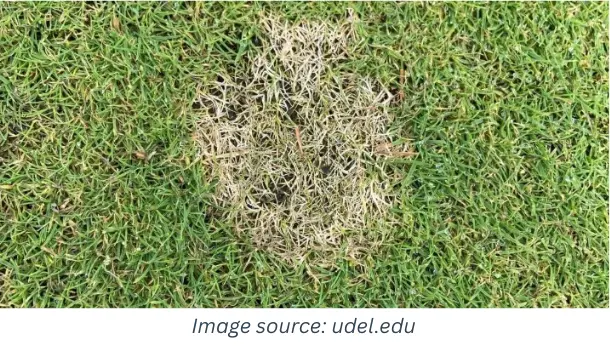
-
What it is: A foliar disease that thrives in warm days, cool nights, and long periods of dew.
-
Threat Level: Low to Moderate. While it can make a lawn look unsightly, it's mainly a leaf disease. However, if left unchecked for a long time under ideal conditions, it can become more severe.
-
Key Cause: The University of Wisconsin-Madison notes that low nitrogen fertility and drought stress make turf more susceptible.
-
Treatment: Like Red Thread, proper fertilization and watering are key. Water deeply but infrequently, and do it in the morning so the grass can dry during the day. Fungicides are usually not needed for home lawns and should be a last resort.
Problematic Fungi: When to Consider Treatment
These diseases infect the roots and crowns of the grass, and can cause significant, lasting damage if not addressed. For these fungi, a professional fungicide application is often the best course of action.
3. Necrotic Ring Spot
This is a tricky one. Necrotic Ring Spot is a root-rotting fungus that creates large, doughnut-shaped rings of dead, straw-colored grass, often with a healthy-looking green patch in the middle (the "frog-eye").
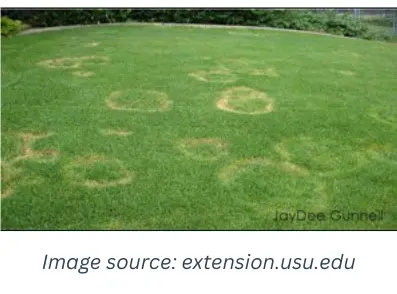
-
What it is: A serious root disease caused by a soil-borne fungus.
-
Threat Level: High. Because it attacks the roots, Necrotic Ring Spot can kill large sections of your lawn. According to Michigan State University Extension, symptoms often appear in the summer heat when the damaged roots can't take up enough water, but the infection actually occurs during the cool, wet weather of spring and fall.
-
Key Cause: It's most severe in sodded Kentucky bluegrass lawns between 2-10 years old. Soil compaction and improper watering (too frequent and shallow) contribute heavily.
-
Treatment: This fungus is difficult to manage. Cultural practices like aeration and deep, infrequent watering are crucial. However, due to the destructive nature of the disease, preventative and curative fungicide applications are highly recommended. A professional application timed for spring or fall, when the fungus is active, is most effective.
4. Pythium Blight (Grease Spot)
If you see small, dark, water-soaked spots on your lawn that quickly merge into larger, matted-down areas that feel greasy or slimy, you could be dealing with Pythium Blight. It often follows drainage patterns and can have a white, cottony growth in the early morning.
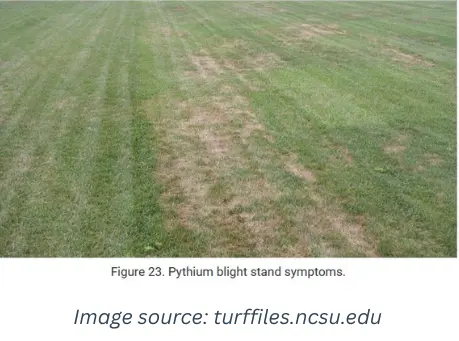
-
What it is: A highly destructive disease caused by a water mold.
-
Threat Level: Very High. Pythium can spread incredibly fast—sometimes killing large areas of turf overnight. Purdue University Extension calls it one of the most damaging turf diseases because of how quickly it moves.
-
Key Cause: It thrives in the hottest, most humid weather, especially when nights are warm (over 68°F) and the turf stays wet for long periods. Poor drainage and lush, over-fertilized lawns are highly vulnerable.
-
Treatment: Because of its speed and destructive power, fungicides are essential tools for controlling Pythium Blight. If your lawn has a history of Pythium, a preventative fungicide program is the best defense during hot, humid spells.
What Should You Do?
Understanding what’s happening in your lawn is the first step. For cosmetic issues like Red Thread and Dollar Spot, improving your lawn care practices can make a huge difference. But for destructive diseases like Necrotic Ring Spot and Pythium Blight, timely professional intervention is critical to save your turf.
If you're seeing any of these signs in your lawn, don't hesitate to reach out. We can provide a professional diagnosis and recommend the right treatment plan to protect your investment and keep your lawn healthy and beautiful.

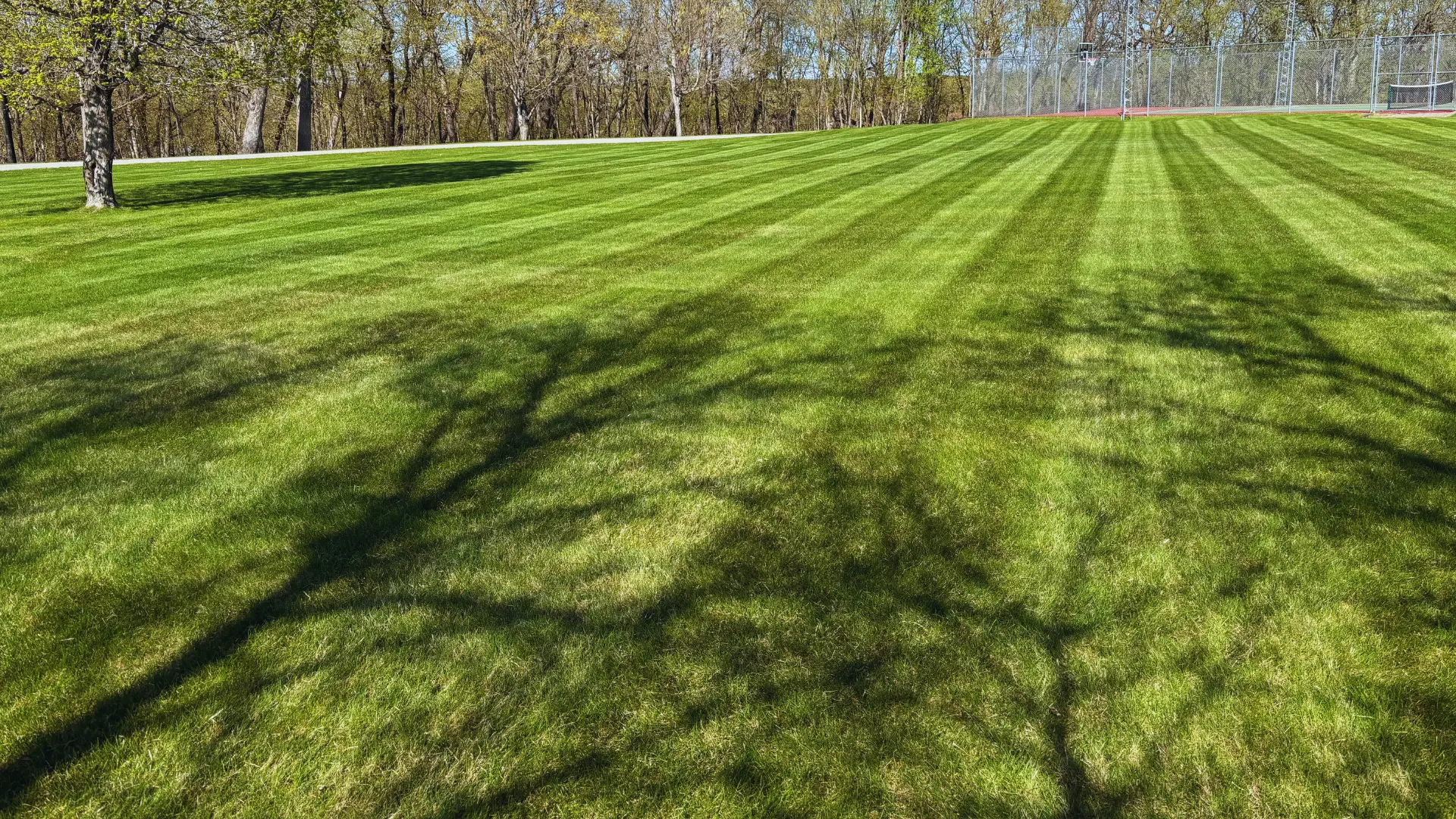
Comments (0)
Sorry! The comments have been closed.